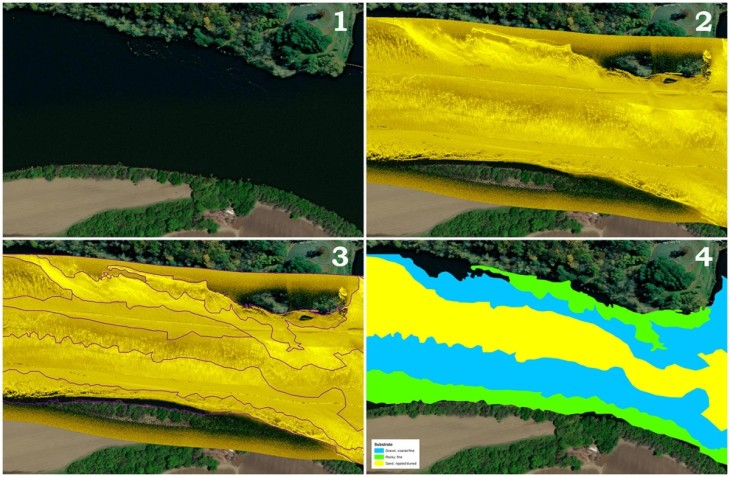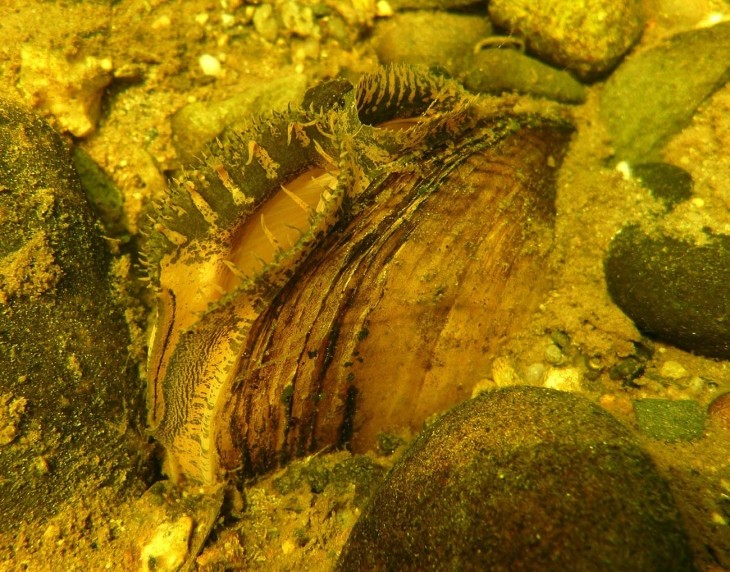
The yellow lampmussel (Lampsilis cariosa) is a freshwater mussel native to medium and large rivers and lakes throughout New England, including the Connecticut River and Housatonic River watersheds. Although it was long considered extirpated from the Connecticut River watershed, researchers rediscovered the species in 2006, and it is listed as endangered in both Connecticut and Massachusetts. Because yellow lampmussel is intolerant of pollution and sedimentation, its presence is a sign of improving water quality. Researchers hope to boost populations by releasing lab-raised individual mussels into historic habitat. Current research focuses on better understanding of the species’ life cycle needs and where to look for suitable habitat.
Since the mussels’ rediscovery, aquatic ecologist Ethan Nedeau has been conducting population estimates and mark-recapture studies on the known populations of yellow lampmussel, trying to determine their health and extent. His work has helped locate a 50-mile segment of river spanning Connecticut and Massachusetts where these mussels live. Yellow lampmussel “has a discontinuous distribution that we do not fully understand,” Nedeau said.
Yellow lampmussel prefers sandy or silty substrates and can be identified by its up to 5-inch, ovate, bright yellow shell, which becomes brownish with age, as well as by the two pseudo-cardinal (interlocking hinge) teeth on its valves, usually located under the beak. Its reproductive cycle begins in late summer with females filtering male sperm out of the water through their gills. The eggs develop internally into larvae called glochidia. When ready to be released, broods of glochidia are stored in structures called conglutinates, extensions of the mantle (muscle) tissue that have evolved to resemble prey such as a minnow or crayfish. When a hungry fish takes the bait, the conglutinate breaks open, releasing a mouthful of glochidia. The larvae immediately attach to the fish’s gills, where for several weeks they feed off its body fluids (which doesn’t significantly harm the fish) until they are developed enough to drop off and settle into the stream bottom sediment.
At the Richard Cronin Aquatic Resource Center, a former fish hatchery turned state-of-the-art research facility in Sunderland, Massachusetts, Director David Perkins oversees staff and students raising several species of native mussels in tanks, including brook floater (Alasmidonta varicosa), dwarf wedgemussel (Alasmidonta heterodon), and yellow lampmussel. Among the questions they are investigating are which fish species provide the best conditions for developing glochidia, growth rates once the mussels settle into the substrate as adults, and the mussels’ tolerance to changing water quality and other conditions. Researchers hope that this work will help guide reintroductions of native mussels, siting them where they will be most successful.
The team has already had success with the endangered brook floater. They released lab-raised individuals in the Connecticut River to supplement natural populations, guided by the results of studies conducted at the Center.
Extending that work will require a better understanding of the diversity and functioning of habitat types across the watershed. “There has never been a comprehensive benthic [water bottom] habitat assessment done in the Connecticut River, so one of our major objectives is to do that,” said Perkins. “It’s time we got some underwater maps analogous to what we have with terrestrial maps for better management of our rivers.”
Using sidescan sonar, the team has begun mapping the 50-mile segment of river where yellow lampmussel is present. The resulting scan is a highly detailed map of the river bottom that enables scientists to distinguish between cobble, sand, gravel, mud, and vegetated areas. Later, researchers return with divers or cameras to verify the scan’s accuracy. Ecologists such as Nedeau may then be enlisted for population surveys of yellow lampmussel in areas identified as having the right combination of substrate, temperature, depth, and water flow.
“We’re still very rudimentary in our knowledge about their habitat requirements,” said Perkins. “Like birds, each species serves a different ecological role.”
Nedeau notes that propagation and reintroduction alone are not a viable long-term strategy for species recovery. He insists that wider-scale stream and watershed restoration must also occur for reintroductions to be successful. “I don’t think it’s a matter of either/or, but rather all scientists and resource managers using their unique expertise and tools toward a common goal,” he said.
Tools such as benthic mapping may prove crucial to mussel conservation efforts nationwide. Nine of the 12 species of freshwater mussels known to live in the Connecticut River are imperiled in all or parts of their range. “It’s hard to generalize about the decline in native mussels,” said Nedeau, “and better to think about species-specific and habitat-specific trends.” The future of freshwater mussel conservation will increasingly cater to that specificity, as scientists better understand how to tailor restoration by habitat type in aquatic environments.



